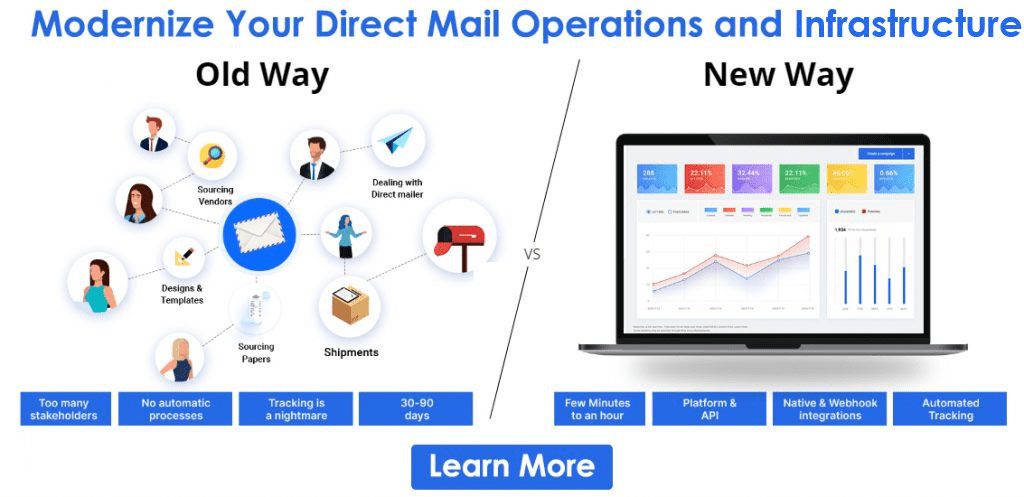Direct Mail Marketing KPIs
Direct Mail Marketing KPIs
Marketers put a lot of time and effort into direct mail campaigns. Hence, it is important to come up with some metrics to measure their campaign performance. These metrics are also called direct mail KPIs (Key Performance Indicators).
At times, businesses conduct a successful campaign but are unaware of the reason for its success. In the same way, some businesses fail to get a positive ROI but are unaware of what went wrong. It is a lot of guesswork and they never get an accurate answer.

How many people responded to your mail items? How many of these respondents bought from you? These are some important questions to answer after a campaign.
KPIs can help you find the answers to such questions. But, you need to first identify and define your direct marketing campaign KPIs.
Direct mail data is overwhelming. There are a lot of facts and figures involved and you should know what to do with them. Defining KPIs is your first step towards figuring out such things.
 Also Read: Segmentation of Direct Mail Data
Also Read: Segmentation of Direct Mail DataThe most common KPIs are the number of responses and total revenue earned. But, you cannot stop after knowing these things; there’s more to find out.
In this article, we will discuss several different KPIs that you can use and their usefulness.
Tips to Remember While Using Direct Mail Marketing KPIs
Any direct mail marketer can use these metrics easily. Apart from that, we have also mentioned how to calculate the metrics. Keep the following things in mind to explore KPIs and select the right ones:
KPIs Should Support Your Campaign Objectives
Choose indicators that support and reflect your objectives clearly. They should be a direct link between them.
For example, if your objective is high engagement, you should measure response levels. This way, it is easier for you to find out whether you fulfilled your aim.
KPIs Must Correspond With Your Sales Plans
Yes, that’s true, your KPIs should also correspond with your sales plans. Marketers should associate with the sales team to get their plans aligned.
If possible, focus on prospects that your sales team is already in touch with. It gives an extra touchpoint for your sales team to close deals.
Define Your Data Precisely
Choose KPIs that can help measure campaign performance with precision. You need clear numbers and full-proof reports. Hence, your selected direct marketing KPIs should be easy to use and understand.
Plan the Tools Required for Using KPIs
You cannot use certain KPIs without additional help. It might be easy to calculate responses but it is difficult to tie them to particular campaigns.
Your best bet is to use certain programs and expert sources. PostGrid can help you measure your campaign success through popular KPIs.
Gather Feedback and Implement It
Defining and using KPIs is not a one-time task. Companies can evaluate their KPIs from time to time to check their effectiveness. Redefine and revise indicators as required to assure that you get the best data possible.
8 Most Commonly Used Direct Mail Marketing KPIs and Metrics
All KPIs work with the help of trackable features of direct mail items like pURLs. So, make sure that you provide recipients with enough options to respond to your mailer.
Don’t forget to add exciting offers that motivate recipients to complete the CTA. Below are some commonly used direct-response marketing KPIs:
1. Response Rate
Direct mail has a response rate of 9% for in-house lists and 4.9% for mailing to prospects. These rates are way ahead of email, paid search, and social media marketing.
Response rate is one of the most important direct mail KPIs. You can get an idea of how well recipients reacted to their mail.
It is the percentage obtained by dividing the total campaign size by the number of responses. This rate varies due to several factors like your mail design and mailing list relevancy.
But, what counts as a response and how can you track them?
We have enlisted four methods to track responses below. You can use these or develop your own response-tracking mechanisms.
Coupon Codes
Who doesn’t like getting coupons? Coupons offer certain discounts that encourage people to buy from you. All they have to do is enter the one-time use coupon code during checkout.
Provide unique coupon codes for every campaign. Ask recipients to redeem these codes by visiting your website or physical store.
The number of coupons redeemed equals the number of responses generated.
Phone Number
Call tracking is another smart and efficient way to track responses. Include a unique phone number in all your mail items.
This should be a dedicated line attributed only to one campaign. So, any calls on this toll-free number count as responses.
It is advisable to use a toll-free number for this method to work.
PURLs
Personalized URLs are attractive and impressive. Basically, they are URLs that take recipients to a personalized webpage. You can also add the person’s name in the link itself.
For example, www.postgrid.com/noah-kavinsky.
 Also Read: How do PURLs work?
Also Read: How do PURLs work?All website visits are recorded as responses. Your website analytics data can help you know the exact number of responses. This data will also have the names of the people who responded.
QR Codes
QR codes are often used along with pURLs. Some people might not want to enter the complete link address manually, so QR codes offer a shortcut.
Print a QR code on your mail items and ask recipients to scan it. The code will take people to their personalized web page directly. Again, it is a great way to get more responses.
 Also Read: QR Code Advertising Combined With Technology
Also Read: QR Code Advertising Combined With TechnologyQR codes work great for a lot more things. You can redirect people to their shopping carts for completing checkouts. Or, redirect them to your online catalog. There are various such possibilities for you.
Let’s consider an example to demonstrate response rate calculations:
Imagine your campaign size is 10,000. Out of 10,000 mailings, you received 500 responses.
The response rate will be 500/10,000 x 100 = 5%.
The calculation is very simple, which is one of the reasons why the response rate is an excellent KPI.
You can also send out two different batches with two different offers to test them. The one with the higher response rate is the better one.
2. Cost Per Response
It is exciting to get a higher number of responses after a campaign. But sometimes, the cost to get those responses is way more than the revenue.
So, you can be at a loss even after getting a lot of responses. Not all campaigns with high response rates are successful.
The cost per response tells you whether it is worth spending on a campaign. You can estimate the number of responses beforehand to calculate this KPI.
If the cost per response is less than the revenue earned, you can go ahead with your campaign budget. Otherwise, look for ways in which you can spend less.
If you want to know how much it costs you to get those responses, calculate the cost per response. Divide the total campaign cost by the number of responses.
For example, if your total campaign cost is $25,000 and you got 200 responses.
The cost per response is $25,000/200 = $125.
You spent $125 on every response. But, how will you know whether spending this amount was useful or not? To do this, you should calculate the cost per acquisition.
3. Cost Per Acquisition
The cost per acquisition is another important KPI for measuring direct marketing performance.
It is crucial to know whether the cost you spent on every acquisition is more or less than the revenue earned. If it is more, your campaign can fail.
But, if there is any profit margin, it can succeed. Imagine spending $1,000 on a customer who only bought products worth $100.
This metric tells you how much it cost the company to acquire a customer. It could be a new customer or an existing customer who bought from you again.
The thing that matters is how many people decided to buy from you after receiving your mail.
This metric helps you to compare your direct mailing efforts with other channels. This way, you can determine which channel is the most effective and affordable.
For instance, your entire campaign cost is $15,000. You receive a whopping 400 responses from among 5,000 recipients. Only 150 converts from these responses.
Cost per acquisition will be $15,000/150 = $100.
Profit Per Acquisition: Let us take this example a little further to find out how much you actually earned. Imagine these 150 customers bought an annual subscription from you worth $150. In this case,
Profit per acquisition is $150 – $100 = $50.
So, for every $100 spent, you earned $150. This statistic states that your campaign was a success.
4. Return on Investment (ROI)
How to measure direct mail? The easiest and best way to do so is to find the campaign ROI. It is the total profit made out of a campaign. The ROI determines whether the campaign was successful.
Though marketers aim at positive ROI, they may fail sometimes. Some campaigns fail due to improper timing, irrelevant offers, and other reasons.
Yet, pulling off campaigns that generate a positive ROI is not difficult. Keep a few essential things in mind and you are good to go. You can also take help from a direct mail automation company like PostGrid.
Direct mail campaigns can generate an ROI of 29%. This figure is commendable and proves that direct mail has the potential to perform well. It is quite simple to calculate your campaign ROI. To begin with, subtract the campaign cost from your total revenue. The answer is your profit.
The percentage obtained by dividing the profit amount by the campaign cost is your ROI.
For example, your campaign cost is $10,000 and your revenue is $12,000. The difference of $2,000 is the profit. The formula to calculate ROI is
ROI = Profit amount/ Campaign cost x 100
or
ROI = $2,000/ $10,000 x 100
So the ROI here is 20% of your investment.
5. Customer Acquisition KPIs
You can use direct mail for both acquiring new customers and retaining existing ones. Plan specific campaigns focused on these objectives.
There are different digital direct response marketing KPIs to measure performance. They help you understand whether the campaign succeeds in achieving your pre-defined goals.
Visitor-to-Lead Ratio
Many websites attract a lot of traffic, but it is difficult to say if it’s useful. Thus, there should be a metric that informs you how many of these visitors become leads. As the name goes, the visitor-to-lead ratio tells you exactly that.
There is another metric called the lead-to-sale ratio. It tells you how many leads convert into customers.
If you get a large number of leads but your lead-to-sale ratio is low, there is something wrong. But, if you manage to get a high lead-to-sale ratio even with a few leads, you are on the right track. Such metrics show that lead quality matters more than quantity.
Channel-Wise Sales Revenue
Using this KPI, you can allocate your marketing budget smartly. Identify the channels that can help you acquire more valuable customers.
Understand your direct mail campaign results better by comparing them with other channels. Thus, you can find out if direct mail is working for you. Furthermore, marketers can balance their marketing effort and budget.
Landing Page Conversion Rate
Oftentimes, marketers overlook the landing page conversion rates, which is clearly a mistake.
It is not enough to get people to visit a landing page. You should know how many of your landing page visitors converted.
It is when the landing page conversion rates come in handy. Also, this metric tells you a lot about the effectiveness of your landing pages.
Visitors may not buy from you if your landing page is not creative and helpful. In this case, your landing page conversion rate can see a sharp decline.
Make use of these insights and modify your landing page design and offer accordingly.
6. Customer Retention KPIs
You can design good marketing KPIs on the basis of customer retention. These indicators help companies improvise their retention strategies.
Not all customers stay with you for a long time. Some move to different places, while some shift to cheaper brands. The point is that a decent percentage of customer churn is inevitable.
Businesses should focus on their most loyal and valuable customers. Plan campaigns that focus on customers. You can send thank-you postcards with a discount to your most loyal customers.
Customer retention KPIs can measure the effectiveness of such strategies.
7. Customer Lifetime Value (CLV)
Companies spend 5 times more to acquire new customers than to retain them. Hence, retaining customers is crucial for your profits.
Sometimes, companies spend more money on acquiring customers than the generated profit. Imagine spending $100 in acquiring a customer who only buys a product worth $60 from your brand. It’s a clear loss.
Hence, you need to determine the lifetime value of customers. Calculating CLV is a little more complicated than other metrics, but it is important. Take the total revenue earned from a customer over a time period and subtract the spent costs.
For better clarity, let us consider an example. Company ABC spends $200 to acquire a customer named Daniel. The first thing that Daniel purchases from company ABC is worth $560. After two years, Daniel visits their shop again and makes another purchase worth $320.
If you consider a time frame of 2 years, Daniel spent a total of $880 on company ABC. On the other hand, the company spent only $200 on him. Subtract both these amounts and you get the CLV. In this example,
The CLV is $880 – $200 = $680
8. Customer Retention Rate (CRR)
This KPI is very easy to calculate and straightforward. It tells you the number of retained customers.
Also, this indicator offers insights into your customer retention plans. You can find out which strategies are working in your favor and which are not. A good CRR is crucial for your company’s growth. It indicates that your customers are loyal to your brand.
To calculate CRR, use the following formula:
CRR = Total number of customers at the end of a period/ Total number of customers at the start x 100
For example, you have 400 customers as of 1st January 2023. Consider the total number of customers present as of 31st December 2023. In this example, the number is 290. So, CRR = 290/400 x 100 = 72.5%
Here, the CRR shows that you were able to retain only 72.5% of your total customers. Based on your marketing activities, it can be both a good and bad CRR.
Attrition Rate
The attrition rate is the exact opposite of CRR. It measures customers lost in the churn. In the above example, the company lost 110 customers.
Attrition rate = Total number of lost customers at the end of a time period/ Total number of customers at the start x 100
or
Attrition rate = 110/400 x 100
So the Attrition Rate here is 27.5%. You can also minus the CRR from 100 to get the attrition rate.
Conclusion
How to measure direct mail effectiveness? In the past, it was very difficult to answer this question. But, nowadays, there are several indicators that can answer such questions for you.
KPIs make it possible to turn vast, unarranged data into solid reports. See which aspects work for your business and which ones need to be eliminated.
PostGrid’s direct mail API can help you conduct and track direct mail campaigns. You can access all your campaign reports through the dashboard.
There is no need to calculate anything by yourself. PostGrid makes the entire process much easier and simpler.
Request a Demo Now to Learn How You Can Make the Most of Your Direct Marketing KPIs.
Ready to Get Started?
Start transforming and automating your offline communications with PostGrid
The post Direct Mail Marketing KPIs appeared first on PostGrid.
source https://www.postgrid.com/direct-mail-marketing-kpis/




Comments
Post a Comment